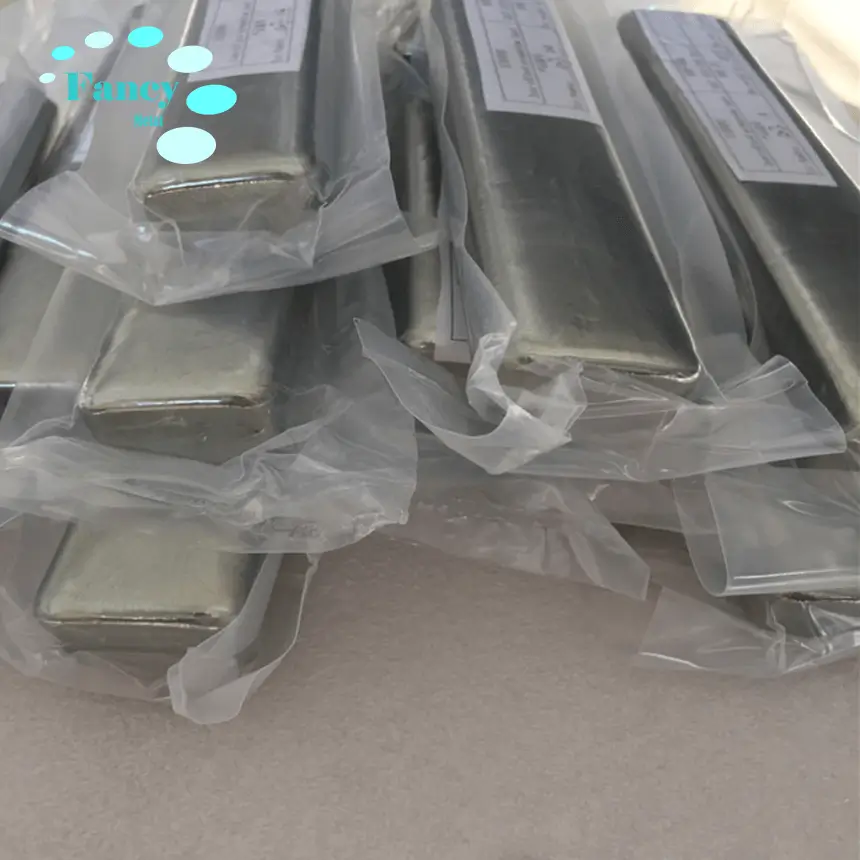Fancymetal offers high purity (customizable) metal products, as well as oxides, product shapes, foils, plates, wires, tubes, rods, powders and a variety of custom shapes.
We also have other germanium products:
Germanium
Germanium Metal
Germanium powder
Germanium particles
Germanium oxide
Germanium Sputtering Target
Germanium is a grayish white semimetal, shiny, hard, and belongs to the carbon family
Germanium has good semiconductor properties, such as electron mobility, hole mobility, etc. The development of germanium still has great potential.
Chemical properties:
Germanium has stable chemical properties and does not react with air or water vapor at room temperature, but quickly generates germanium dioxide at 600-700℃. It does not react with hydrochloric acid and dilute sulfuric acid. When concentrated sulfuric acid is heated, germanium will slowly dissolve. In nitric acid and aqua regia, germanium is easily soluble. The effect of alkaline solution on germanium is very weak, but molten alkali in the air can make germanium dissolve quickly. Germanium does not react with carbon, so it will not be contaminated by carbon when melted in a graphite crucible.
Preparation method:
The extraction method of germanium is to first chlorinate the germanium concentrate with concentrated hydrochloric acid to produce germanium tetrachloride, then use hydrochloric acid solvent extraction to remove the main impurity arsenic, and then purify it twice through quartz tower distillation, and then wash it with high-purity hydrochloric acid to obtain high-purity germanium tetrachloride. Use high-purity water to hydrolyze the germanium tetrachloride to obtain high-purity germanium dioxide.
Some impurities will enter the hydrolysis mother liquor, so the hydrolysis process is also a purification process. Pure germanium dioxide is dried and calcined, and reduced with hydrogen at 650-680℃ in the quartz tube of the reduction furnace to obtain metallic germanium. High-purity germanium (impurities less than 1/1010) for semiconductor industry can be obtained by zone melting technology.
4HCl+GeO2→GeCl4+2H2O
GeCl4+(n+2)H2O→GeO2·nH2O+4HCl
GeO2+2H2→Ge+2H2O
Applications:
✔ Germanium has many special properties and has extensive and important applications in semiconductors, aerospace measurement and control, nuclear physics detection, optical fiber communications, infrared optics, solar cells, chemical catalysts, biomedicine and other fields. It is an important strategic resource.
✔ In the electronics industry, in alloy pretreatment, and in the optical industry, it can also be used as a catalyst.
✔ High-purity germanium is a semiconductor material. Germanium single crystals can be used as transistors and are the first generation of transistor materials. Germanium materials are used for radiation detectors and thermoelectric materials.
✔ High-purity germanium single crystals have a high refractive index, are transparent to infrared rays, and do not transmit visible light and ultraviolet rays. They can be used as germanium windows, prisms or lenses that transmit infrared light.
✔ Germanium and niobium compounds are superconducting materials. Germanium dioxide is a catalyst for polymerization reactions. Glass containing germanium dioxide has a high refractive index and dispersion performance. It can be used as a wide-angle camera and microscope lens. Germanium trichloride is also a new type of optical fiber material additive.
Storage and transportation:
It should be stored in a cool, ventilated, dry, clean warehouse without chemical corrosion atmosphere. Moisture-proof. It cannot be stored and transported together with acidic and alkaline products. It should be protected from rain and shock during transportation. Be careful when loading and unloading to prevent collision and rolling and mechanical damage.
Advantages:
✔ Strict quality control of raw materials, process control and pre-delivery processes.
✔ Strong technical capability makes it a reliable long-term supplier.
✔ Technical support: 24 hours technical support by email or phone.
History:
Mendeleev predicted its existence in 1871. Fourteen years later, German chemist Winkler discovered germanium when analyzing argyrodite in 1885. Later, germanium was produced by heating germanium sulfide with hydrogen. Mendeleev named it silicon-like.
In 1886, while analyzing a new mineral found near Freiberg, argyrodite (4Ag2S·GeS2), Professor of Analytical Chemistry at the Freiberg Mining Academy (TU Bergakademie Freiberg in the 21st century), Winkler discovered an unknown new element and verified his inference through experiments. Germanium was finally discovered.

